Sony A6000 besides most prominent feature of Auto Focus performance, brought also new (in Sony camera range) 24 Mpx sensor design.
While the resolution remain same as it was on NEX 7 sensor, Sony claim that new sensor has gap-less design, new micro-lenses and of course is linked to the new processor - Bionz X.
I can't speak about JPEG performance, because I am not experienced in JPEG settings, but I was curious to see, how does it improve corner performance in Sony ARW format. (Considered as a RAW, but lossy compressed with software corrections hard coded).
To be honest, while testing AF was rather out of curiosity as I rarely use it, corner performance for me was of a most interest and A6000 didn't dissapoint there.
With NEX 7, most IQ problems (besides lossy compression) were related to the magenta color casting and excessive corner smearing with most symmetrical designed WA lenses for RF cameras.
With the later firmware, Sony applied (in RAW) greenish counter mask to suppress magenta casting, and that resulted in overall improvement, but using lenses without electronic communication involved lot of unpredictable results especially in different lighting conditions.
I went back to original firmware because of that and learned to use Adobe Flat Field plug-in for NEX 7 images taken with problematic lenses. One of those was Sony's native SEL 1018 f/4 OSS, mainly at 10mm end, lens that otherwise is my most used E-mount landscape optics.
Using additional post processing, it was usually possible to get rid of the color casting (but not always easy), however firmware updates couldn't do much about corner smearing. I never had two NEX 7s side by side, and when new firmware is installed it can't be rolled back, so I couldn't make direct comparison, but I have feeling that NEX 7 with later firmwares did crop images a bit, trying to improve corner performance, by cutting out extreme corners and interpolating resulting image.
Finally, with original NEX 7 firmware I never had problem with blotchiness in intensive gradual transitions, that I experienced with firmware 1.01 and all later Sony E-mount bodies. Different compression algorithm or psychosomatic problem?
For all those reasons (and few others that I wrote about some time ago - http://verybiglobo.blogspot.cz/2013/01/sony-nex-7-firmware-101-metabones.html)
I am still using NEX 7 with its original firmware, so regarding color casting, comparison results presented here are not representative for the latest firmware upgrades.
But even with those, I witnessed lot of magenta and smearing problems with lens like CV Heliar 15/4.5 e.g. from my friend who is using it.
Another friend borrowed me that lens shortly, to see how does it work on Alpha 6000 and here are few results for your consideration.
And few with crops from SEL1018 f/4 OSS at 10mm
And related extreme corners crop - notice the reduced smearing with A6000
In the last comparison image, you might notice subtle, but existing difference in detail resolving ability, especially on the "windows" crop. This slight "clarity" or even resolution improvement could be due to the new sensor design or even weaker AA filter.
I found A6000 IQ to be noticeably improved especially in the corners and with legacy Heliar. Don't get me wrong, NEX 7 is still great camera when it comes to IQ, and with some pp you can have almost identical results, but A6000 images are better in that respect, right out of the box.
When it comes to high ISO, A6000 images converted from RAW in LR 5.4 with standard settings, are actually pretty impressive.
Here is one comparison image of 4 cameras 100% crop night shot from tripod at ISO 6400
I am working on few more comparisons layouts from 100% crops including Sony A7, A7r, Nikon D800E and few more cameras. When I finish them, they will be posted here. Meanwhile, you can check full size images on the dedicated - Flickr albums.
1 - ISO comparison at original image size (click to open)
I might be also able to give you link to download original RAWs only to explore them for yourself (not for any unauthorized publishing purposes). If interested, leave message in the comment box bellow, and don't forget to register, so that I can send you PM or email with the link.
So far A6000 seems like very interesting APS-C camera, that is certainly at the top of current technologies.
To help this page survive, your donation will be highly appreciated.
While the resolution remain same as it was on NEX 7 sensor, Sony claim that new sensor has gap-less design, new micro-lenses and of course is linked to the new processor - Bionz X.
I can't speak about JPEG performance, because I am not experienced in JPEG settings, but I was curious to see, how does it improve corner performance in Sony ARW format. (Considered as a RAW, but lossy compressed with software corrections hard coded).
To be honest, while testing AF was rather out of curiosity as I rarely use it, corner performance for me was of a most interest and A6000 didn't dissapoint there.
With NEX 7, most IQ problems (besides lossy compression) were related to the magenta color casting and excessive corner smearing with most symmetrical designed WA lenses for RF cameras.
With the later firmware, Sony applied (in RAW) greenish counter mask to suppress magenta casting, and that resulted in overall improvement, but using lenses without electronic communication involved lot of unpredictable results especially in different lighting conditions.
I went back to original firmware because of that and learned to use Adobe Flat Field plug-in for NEX 7 images taken with problematic lenses. One of those was Sony's native SEL 1018 f/4 OSS, mainly at 10mm end, lens that otherwise is my most used E-mount landscape optics.
Using additional post processing, it was usually possible to get rid of the color casting (but not always easy), however firmware updates couldn't do much about corner smearing. I never had two NEX 7s side by side, and when new firmware is installed it can't be rolled back, so I couldn't make direct comparison, but I have feeling that NEX 7 with later firmwares did crop images a bit, trying to improve corner performance, by cutting out extreme corners and interpolating resulting image.
Finally, with original NEX 7 firmware I never had problem with blotchiness in intensive gradual transitions, that I experienced with firmware 1.01 and all later Sony E-mount bodies. Different compression algorithm or psychosomatic problem?
For all those reasons (and few others that I wrote about some time ago - http://verybiglobo.blogspot.cz/2013/01/sony-nex-7-firmware-101-metabones.html)
I am still using NEX 7 with its original firmware, so regarding color casting, comparison results presented here are not representative for the latest firmware upgrades.
But even with those, I witnessed lot of magenta and smearing problems with lens like CV Heliar 15/4.5 e.g. from my friend who is using it.
Another friend borrowed me that lens shortly, to see how does it work on Alpha 6000 and here are few results for your consideration.
And few with crops from SEL1018 f/4 OSS at 10mm
And related extreme corners crop - notice the reduced smearing with A6000
In the last comparison image, you might notice subtle, but existing difference in detail resolving ability, especially on the "windows" crop. This slight "clarity" or even resolution improvement could be due to the new sensor design or even weaker AA filter.
I found A6000 IQ to be noticeably improved especially in the corners and with legacy Heliar. Don't get me wrong, NEX 7 is still great camera when it comes to IQ, and with some pp you can have almost identical results, but A6000 images are better in that respect, right out of the box.
When it comes to high ISO, A6000 images converted from RAW in LR 5.4 with standard settings, are actually pretty impressive.
Here is one comparison image of 4 cameras 100% crop night shot from tripod at ISO 6400
I am working on few more comparisons layouts from 100% crops including Sony A7, A7r, Nikon D800E and few more cameras. When I finish them, they will be posted here. Meanwhile, you can check full size images on the dedicated - Flickr albums.
1 - ISO comparison at original image size (click to open)
I might be also able to give you link to download original RAWs only to explore them for yourself (not for any unauthorized publishing purposes). If interested, leave message in the comment box bellow, and don't forget to register, so that I can send you PM or email with the link.
So far A6000 seems like very interesting APS-C camera, that is certainly at the top of current technologies.
To help this page survive, your donation will be highly appreciated.


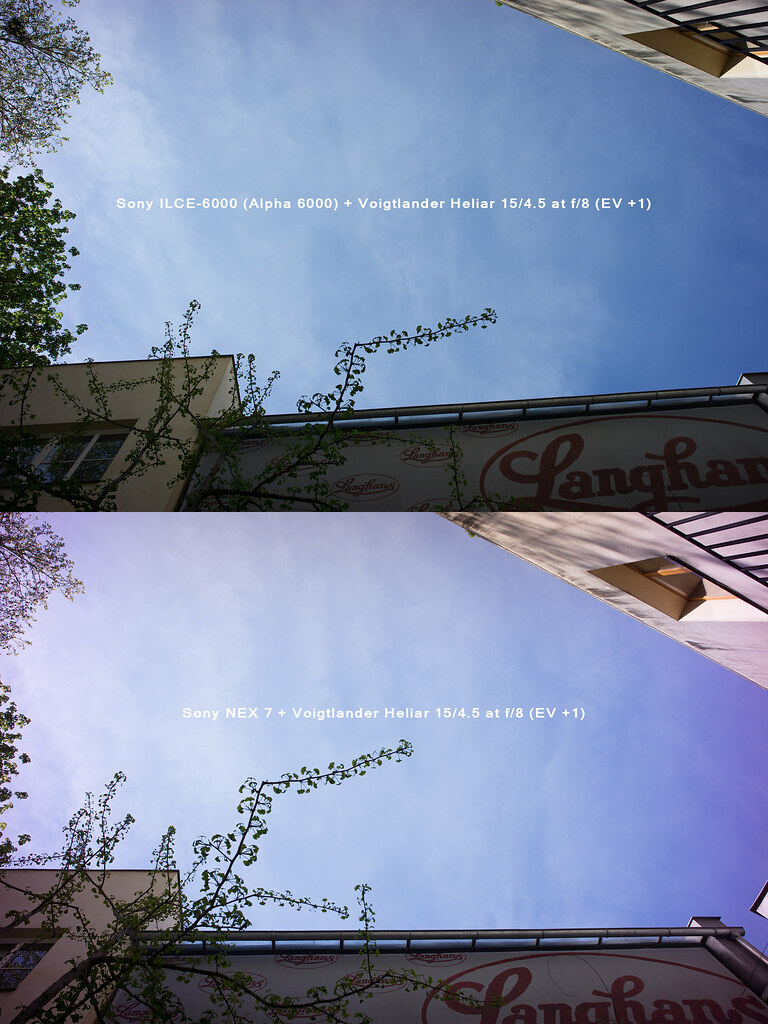
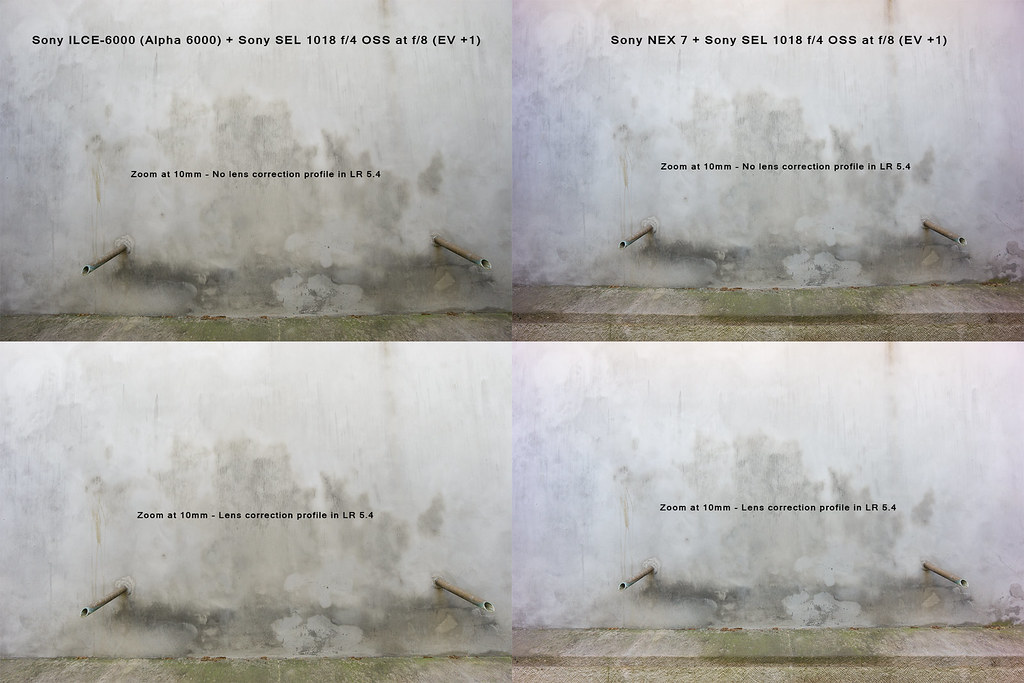

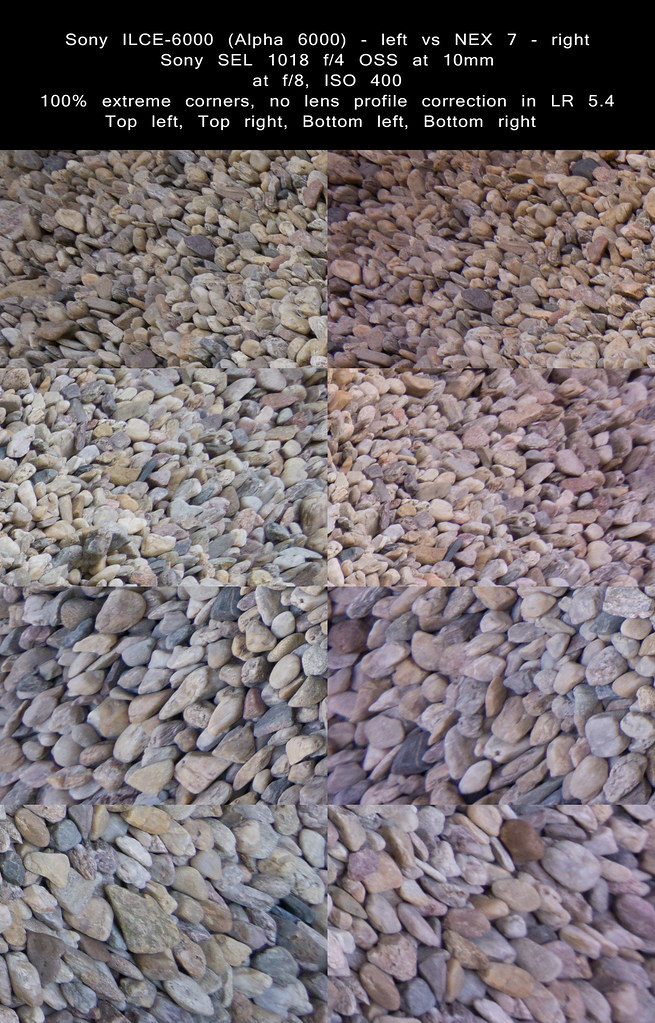
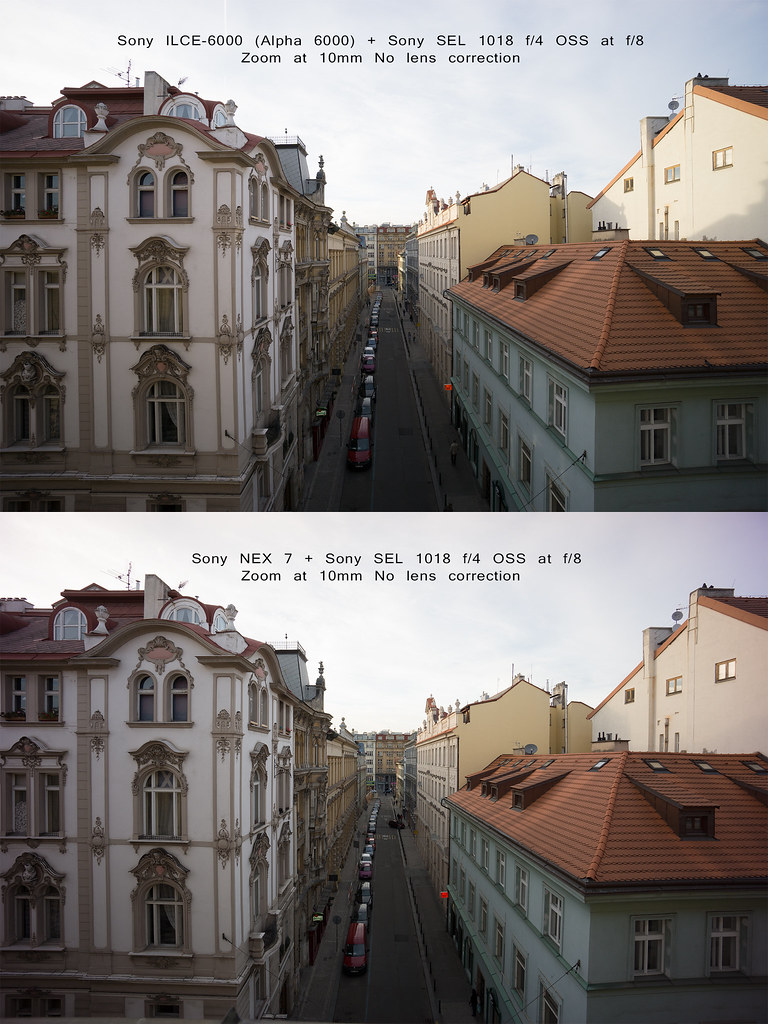
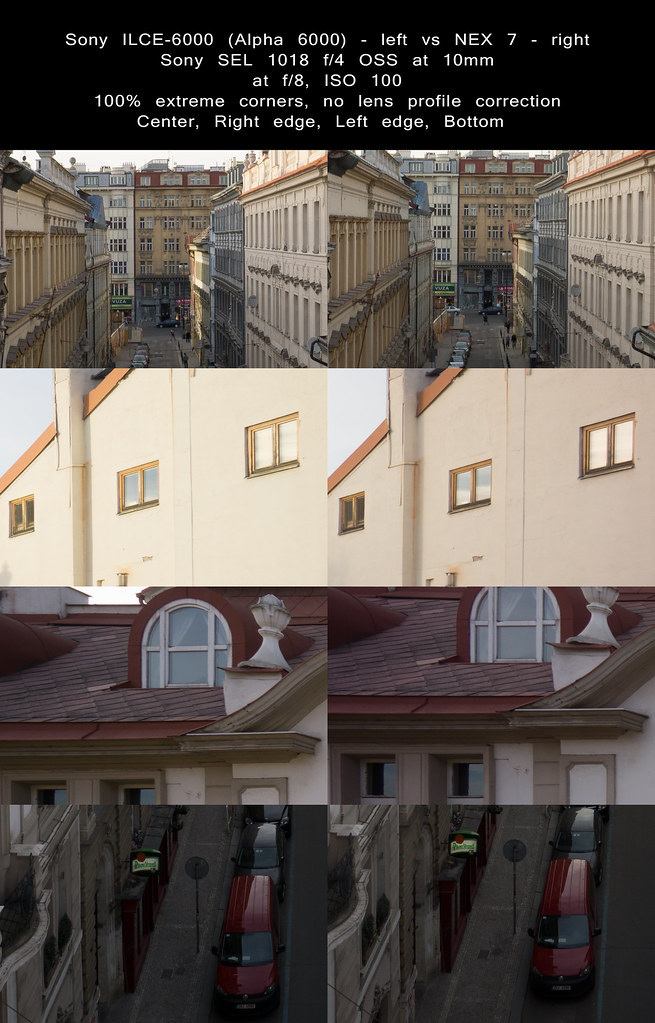
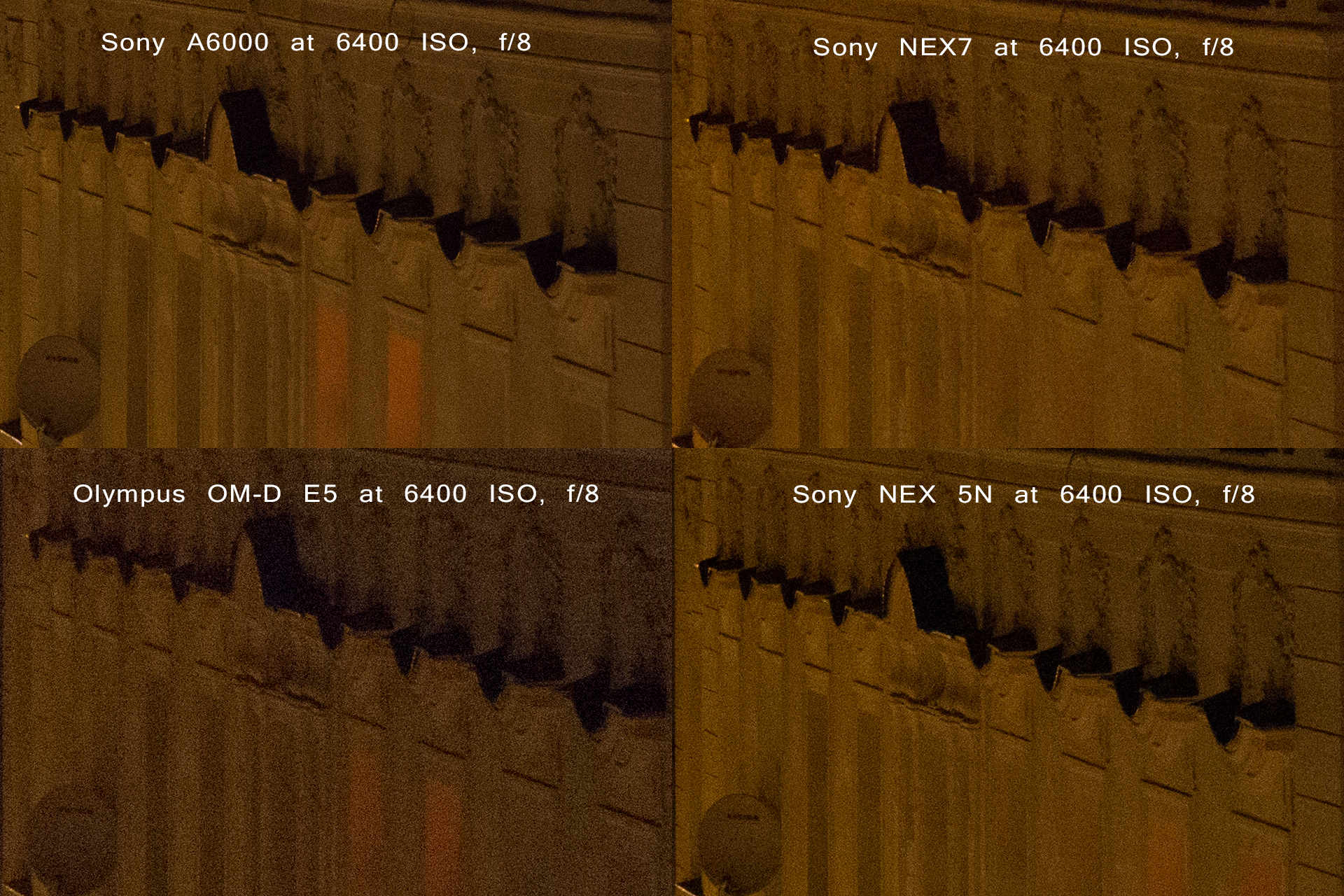
Very interesting. Thank you. A6000 seems to be a great camera. Now i am trying to determine if for me it is APS-C or FE. Different question. Thank you for your work.
ReplyDeleteThank you for looking. There is one of my post few weeks ago, comparing Sony A7 with FE 35/2.8 ZA with NEX 7 with SEL 2418 ZA. Maybe that can help a bit for your sensor size consideration.
DeleteIt looks much improved. Thank you for doing this test it seems nobody else does test like these.
ReplyDeleteAny chance they do the fix in raw on the a6000? Did to test with a manual focus lens too?
ReplyDeleteThank u Viktor for taking the time to make your finding available to all of us so that we may understand these sony machnes/toys better :) ....
ReplyDeleteI am apalled at knowing [from u ]that the A6000 has lossy RAW compression too that is despite the fact that the A7/R received so much negative attention over it ....
the dpr and IR appear to be silent over the issue of lossy RAW compression of the A6000!
Thans. Most of the big reviewers are silent about Sony raw compression. For whatever reason. :-)
DeleteHi again !
DeleteIn my humble opinion ..if Sony do not plug the I.Q lacuna as the very earliest ..it will simply prove the fact that they are not serious about their image quality at all.....rather they are too busy churning out disposable gizmos that sell ....this is sad for us
I hope u do not mind me asking u this but can u give me a link to your finds about the A6000 generating ... lossy RAW files...Thank u !
DeleteHi, I don't have active download link anymore, but here is the link to one of my published observations within DPR forum - http://www.dpreview.com/forums/post/53060443. There are few more references in that post.
DeleteHi Viktor,
ReplyDeleteI've read this post and the one where you compare NEX7 and A7, great posts, btw.
I need to upgrade my old Lumix FZ18 to a better travel camera. The FZ18 is a fantastic powerzoom and serves all-purpose, but now lacking in the IQ department, bokeh and low-light shoots.
I need will be shooting:
• Landscapes (nature): 40%
• Modern architecture, old buildings: 25%
• Food / macro / animals: 5%
• People (full/half body shots): 15%
• Low-light (ie. night scenes, indoor, museums, etc.): 15%
I need the new camera to take beautiful autumn photos in Japan, and this page shows a good variety of examples that I want to take, including nice bokeh, close-up of roof tiles, people in context of surroundings, etc.:
http://www.japan-guide.com/blog/koyo12/121121.html
Weight is consideration as this is still a family travel with the wife, not a photo trip.
I've finalised two contenders that are within my budget:
OPTION 1
Sony A6000 + Zeiss 16-70mm f4 OSS Vario-Tessar T* + Zeiss 32mm Touit f1.8 E
OPTION 2
Sony A7 + Zeiss FE 24-70mm f4 ZA OSS
These are the set that I could afford and I don't like to be in people's face, so I tend to shoot at a distance and seldom do portrait (head/shoulder) shots.
My indecision is caused by going full frame seems to be the better future investment, because of its low light performance and overall IQ. But the A6000 seems to provide me with better angle for landscapes and zoom for distant shots, cheaper lens too. And I know that I will be taking lost of indoor and evening shots, although majority will be daytime landscapes.
Do you have any insights or advise that can tip me either way?
Hi and thank you for the kind words. Both of your choices are valid ones and the difference between the sets would come to better low light performance (high ISO above 1600) of A7 vs better AF of A6000. In the case of A6000, I would personnaly re-consider Touit 32, and will think of some legacy low light options or SEL 24/1.8 Zeiss, because for the interiors, wide is usually better and will let more light in too. Also, if you like FL around 30mm consider SEL 35/1.8 OSS, lens that is very good too and have stabilization which might help with some interior, low light shots.
DeleteI don't think today that we can speek of "smart investment" with a new technologies (light field cameras e.g) around the corner and wild diversity of formats and novelities. Pick the camera that you like now and learn to use it to take most of it. Both - A7 and A6000 are capable of great results.
When it comes to your lens selection, I am not so sure. Inmany tests e.g Sony FE 28-70 showed equal if not better performance than Zeiss 24-70 f/4 and Zeiss 16-70 is not considered to be much better than SEL 18-55 at comparable FL. Both Zoom lenses stays behind its prime brothers - Touits FE and 55 and 35. Maybe you can think of Sony SEL 18-105 G and SEL 10-18 f/4 OSS (great landscape lens) and add fast legacy (Olympus 24/2, Canon FD 24/1.4 L or whatever you can find for reasonable money - Olympus, Pentax, Nikkor 28/2).Together with A6000, that would be my recommandation for you.
Regards,
Viktor
Wow, these are very good insights, Viktor. I was leaning towards A7 because it's FF (many friends said that factor alone is a winning reason), better ergonomics (the grip and reaching the dials feel just right for my hand) and better low light performance so at least all my night and indoor photos would be covered nicely.
DeleteHowever, I struggle to find that affordable versatile lens to go with A7 for my travel, as I most likely won't have the time to keep changing my lens. At the most I can just bring/buy 1 mid range zoom and 1 prime lens for now (will slowly be building my accessories as time goes by).
Your suggestions for the other lenses for A6000 opened up a world of (better) choices that I didn't think about before. To get this right, if I go with the A6000 then the SEL 18-105mm will be my main lens for landscapes, indoors, people and all round zoom needs, right? So when I have that extra time to compose a wider landscape shots, that's when I use the SEL 10-18mm?
I picked the Touit 32mm f1.8 to have a 48mm equivalent fast lens to take med range photos with decent bokeh. I guess the A7 wins in this factor too because I read FF can have shallower DOF at same FOV.
So if I could only get the SEL 18-105mm as my main lens and one more lens for the travel, should that be:
Sony SEL1018 f4,
Zeiss 24mm f1.8 ZA Sonnar T*
Sony 35mm f1.8
Zeiss 35mm f2.8 Sonnar T*
Zeiss 55mm f1.8 Sonnar T*
The legacy lens your recommended would be manual focus right? I'm a bit cautious getting them because I think the AF lens would work better/faster specially when travelling with my wife :)
Any advise is much appreciated :)
Hi,
DeleteI would take SEL1018 as the second lens for travel. With those two lenses (1018 and 18105) you are covered at equivalent 35 from 15mm to 150+mm ant the only thing you might miss is faster lens for low light situations or better subject isolation (shallower DOF). That's where fast legacy 50mm will come handy but yes that's MF only. But if you can keep yout Touit 32/1.8 you are covered all around.
Cheers,
Viktor